Evaluating the Effect of Numerical Schemes on Hydrological Simulations: HYMOD as A Case Study
Abstract
:1. Introduction
2. Materials and Methods
2.1. Data
2.2. HYMOD
2.2.1. Model Configuration
2.2.2. Mathematical Description
2.2.3. Analytical Solution to SMA
2.2.4. Numerical Schemes
2.2.4.1. The Explicit Runge-Kutta Schemes
2.2.4.2. The Partially-Implicit Euler Schemes
2.2.5. Analytical Solutions to QFR and SLFR
2.3. The Downhill Simplex Method (DSM) for Parameter Optimization
2.4. Model Setup
3. Results
3.1. The HYMOD Simulations for the Leaf River Basin with a Priori Parameter Set
3.2. The HYMOD Simulations with Random Parameter Sets
3.3. Sensitivity Analysis
3.4. The DSM Optimization
4. Discussion
4.1. Source of Numerical Error in HYMOD Simulations
4.2. Implications for Hydrological Modeling
5. Conclusions
- (1)
- The results of the HYMOD simulations showed a strong dependence on numerical schemes. Both the order of accuracy and the implicit factor significantly affected the simulated flow hydrograph but in different ways: the implicit factor determined whether the flow hydrograph was overestimated or underestimated, whereas the difference between the numerical and analytical solutions decreased with increasing orders of accuracy. The numerical error in the simulation is originated from the truncation error when using a numerical scheme to discretize the storage equation of the linear reservoirs. For the explicit Runge-Kutta schemes, the magnitude of numerical error decreases with increasing order of accuracy and thus the high-order Runge-Kutta schemes produced better prediction than the low-order Runge-Kutta schemes did. For the partially implicit Euler schemes, the leading error term may change sign as the implicit factor varies, which causes the flow hydrograph to be overestimated and underestimated.
- (2)
- Numerical error induced by unsuitable numerical schemes may distort the response sensitivity surfaces of hydrological models and cause discrepancy in optimized model parameters. Owing to the interaction between numerical schemes and model parameters, model parameters may sometimes compensate for the inadequacy in numerical schemes. However, this is not favorable in model development because the model structural identifiability is compromised by inappropriate implementation of numerical schemes. Therefore, the adequacy of the numerical schemes in hydrological models should be carefully considered.
- (3)
- Results of the numerical tests have important implications for selecting suitable numerical schemes for hydrological models. The performance of a numerical scheme is closely associated with its numerical error, which can be controlled either by reducing the time step or by choosing a numerical scheme that well approximates the analytical solutions. However, reducing the time step is not always feasible in hydrological studies due to issues in data availability. To design a new scheme for a hydrological model without assessing all possible candidates, one needs to understand the link between model performance and the common properties of numerical schemes, such as the order of accuracy and the implicit factor. The use of lower-order explicit schemes should be avoided and the low-order implicit schemes should also be used with caution in hydrological modeling studies. On the other hand, high order explicit Runge-Kutta schemes require higher computational cost than the partially implicit Euler schemes. Based on the HYMOD simulations presented in this study, we recommended the use of partially implicit Euler schemes with the implicit factor ranging between 1/3 and 2/3. This study demonstrates that the uncertainty in the output of hydrological models can be effectively reduced by choosing numerical schemes with proper orders of accuracy and implicit factors, which provides an optimized balance between model performance and computational cost.
Author Contributions
Funding
Acknowledgments
Conflicts of Interest
References
- Arnold, J.G.; Srinivasan, R.; Muttiah, R.S.; Williams, J.R. Large area hydrologic modeling and assessment Part I: Model development. J. Am. Water Resour. Assoc. 1998, 34, 73–89. [Google Scholar] [CrossRef]
- Beven, K.J.; Kirkby, M.J. A physically based, variable contributing area model of basin hydrology. Hydrol. Sci. J. 1979, 24, 43–69. [Google Scholar] [CrossRef]
- Bergström, S.; Forsman, A. Development of a conceptual deterministic rainfall–runoff model. Nord. Hydrol. 1973, 4, 147–170. [Google Scholar] [CrossRef]
- Lindström, G.; Pers, C.; Rosberg, J.; Strömqvist, J.; Arheimer, B. Development and test of the HYPE (Hydrological Predictions for the Environment) model – a water quality model for different spatial scales. Hydrol. Res. 2010, 41, 295–319. [Google Scholar] [CrossRef]
- Kitanidis, P.K.; Bras, R.L. Real-Time Forecasting with a Conceptual Hydrologic Model 1. Analysis of Uncertainty. Water Resour. Res. 1980, 16, 1025–1033. [Google Scholar] [CrossRef]
- Kitanidis, P.K.; Bras, R.L. Real-Time Forecasting with a Conceptual Hydrologic Model 2. Applications and Results. Water Resour. Res. 1980, 16, 1034–1044. [Google Scholar] [CrossRef]
- Liang, X.; Lettenmaier, D.P.; Wood, E.F.; Burges, S.J. A Simple Hydrologically Based Model of Land-Surface Water and Energy Fluxes for General-Circulation Models. J. Geophys. Res.-Atmos. 1994, 99, 14415–14428. [Google Scholar] [CrossRef]
- Srinivasan, R.; Ramanarayanan, T.S.; Arnold, J.G.; Bednarz, S.T. Large area hydrologic modeling and assessment - Part II: Model application. J. Am. Water Resour. Assoc. 1998, 34, 91–101. [Google Scholar] [CrossRef]
- Tang, Q.; Oki, T.; Kanae, S.; Hu, H. The influence of precipitation variability and partial irrigation within grid cells on a hydrological simulation. J. Hydrometeorol. 2007, 8, 499–512. [Google Scholar] [CrossRef]
- Samaniego, L.; Kumar, R.; Attinger, S. Multiscale parameter regionalization of a grid---based hydrologic model at the mesoscale. Water Resour. Res. 2010, 46, W05523. [Google Scholar] [CrossRef]
- Best, M.J.; Pryor, M.; Clark, D.B.; Rooney, G.G.; Essery, R.L.H.; Ménard, C.B.; Edwards, J.M.; Hendry, M.A.; Porson, A.; Gedney, N.; et al. The Joint UK Land Environment Simulator (JULES), model description - Part 1: Energy and water fluxes. Geosci. Model. Dev. 2011, 4, 677–699. [Google Scholar] [CrossRef]
- Krysanova, V.; Hattermann, F.; Wechsung, F. Development of the ecohydrological model SWIM for regional impact studies and vulnerability assessment. Hydrol. Processes 2005, 19, 763–783. [Google Scholar] [CrossRef]
- Fenicia, F.; Kavetski, D.; Savenije, H.H.G. Elements of a flexible approach for conceptual hydrological modeling: 1. Motivation and theoretical development. Water Resour. Res. 2011, 47, W11510. [Google Scholar] [CrossRef]
- Kavetski, D.; Fenicia, F. Elements of a flexible approach for conceptual hydrological modeling: 2. Application and experimental insights. Water Resour. Res. 2011, 47, W11511. [Google Scholar] [CrossRef]
- Beck, H.E.; van Dijk, A.I.J.M.; de Roo, A.; Dutra, E.; Fink, G.; Orth, R.; Schellekens, J. Global evaluation of runoff from 10 state-of-the-art hydrological models. Hydrol. Earth Syst. Sci. 2017, 21, 2881–2903. [Google Scholar] [CrossRef]
- Hattermann, F.F.; Krysanova, V.; Gosling, S.N.; Dankers, R.; Daggupati, P.; Donnelly, C.; Flörke, M.; Huang, S.; Motovilov, Y.; Buda, S.; et al. Cross---scale intercomparison of climate change impacts simulated by regional and global hydrological models in eleven large river basins. Clim. Change 2017, 141, 561–576. [Google Scholar] [CrossRef]
- Wagener, T.; Boyle, D.P.; Lees, M.J.H.; Wheater, S.; Gupta, H.V.; Sorooshian, S. A framework for development and application of hydrological models. Hydrol. Earth Syst. Sci. 2001, 5, 13–26. [Google Scholar] [CrossRef]
- Kirchner, J.W. Getting the right answers for the right reasons: Linking measurements, analyses, and models to advance the science of hydrology. Water Resour. Res. 2006, 42, W03S04. [Google Scholar] [CrossRef]
- Gupta, H.V.; Clark, M.P.; Vrugt, J.A.; Abramowitz, G.; Ye, M. Towards a comprehensive assessment of model structural adequacy. Water Resour. Res. 2012, 48, W08301. [Google Scholar] [CrossRef]
- Clark, M.P.; Nijssen, B.; Lundquist, J.D.; Kavetski, D.; Rupp, D.E.; Woods, R.A.; Freer, J.E.; Gutmann, E.D.; Wood, A.W.; Brekke, L.D.; et al. A unified approach for process-based hydrologic modeling: 1. Modeling concept. Water Resour. Res. 2015, 51, 2498–2514. [Google Scholar] [CrossRef]
- LeVeque, R.J. Finite Volume Methods for Hyperbolic Problems, 1st ed.; Cambridge University Press: Cambridge, UK, 2002; pp. 64–86. [Google Scholar]
- Wu, W. Computational River Dynamics, 1st ed.; Taylor & Francis: New York, NY, USA, 2007; pp. 113–174. [Google Scholar]
- ASME V&V 20 committee. Standard for Verification and Validation in Computational Fluid Dynamics and Heat Transfer; American Society of Mechanical Engineers: New York, NY, USA, 2009. [Google Scholar]
- Gorgoglione, A.; Bombardelli, F.A.; Pitton, B.J.L.; Oki, L.R.; Haver, D.L.; Young, T.M. Uncertainty in the parameterization of sediment build-up and wash-off processes in the simulation of sediment transport in urban areas. Environ. Model. Softw. 2019, 111, pp–170. [Google Scholar] [CrossRef]
- Clark, M.P.; Kavetski, D. Ancient numerical daemons of conceptual hydrological modeling: 1. Fidelity and efficiency of time stepping schemes. Water Resour. Res. 2010, 46, W10510. [Google Scholar] [CrossRef]
- Clark, M.P.; Slater, A.G.; Rupp, D.E.; Woods, R.A.; Vrugt, J.A.; Gupta, H.V.; Wagener, T.; Hay, L.E. Framework for Understanding Structural Errors (FUSE): A modular framework to diagnose differences between hydrological models. Water Resour. Res. 2008, 44, W00B02. [Google Scholar] [CrossRef]
- Mendoza, P.A.; Clark, M.P.; Mizukami, N.; Gutmann, E.D.; Arnold, J.R.; Brekke, L.D.; Rajagopalan, B. How do hydrologic modeling decisions affect the portrayal of climate change impacts? Hydrol. Processes 2016, 30, 1071–1095. [Google Scholar] [CrossRef]
- Kavetski, D.; Clark, M.P. Ancient numerical daemons of conceptual hydrological modeling: 2. Impact of time stepping schemes on model analysis and prediction. Water Resour. Res. 2010, 46, W10511. [Google Scholar] [CrossRef]
- Schoups, G.; Vrugt, J.A.; Fenicia, F.; de Giesen, N.C.V. Corruption of accuracy and efficiency of Markov chain Monte Carlo simulation by inaccurate numerical implementation of conceptual hydrologic models. Water Resour. Res. 2010, 46, W10530. [Google Scholar] [CrossRef]
- Moore, R.J. The probability-distributed principle and runoff production at point and basin scales. Hydrol. Sci. J. 1985, 30, 273–297. [Google Scholar]
- Szöllösi-Nagy, A. The discretization of the continuous linear cascade by means of state space analysis. J. Hydrol. 1982, 58, 223–236. [Google Scholar] [CrossRef]
- Nelder, J.A.; Mead, R. A Simplex-Method for Function Minimization. Comput. J. 1965, 7, 308–313. [Google Scholar] [CrossRef]
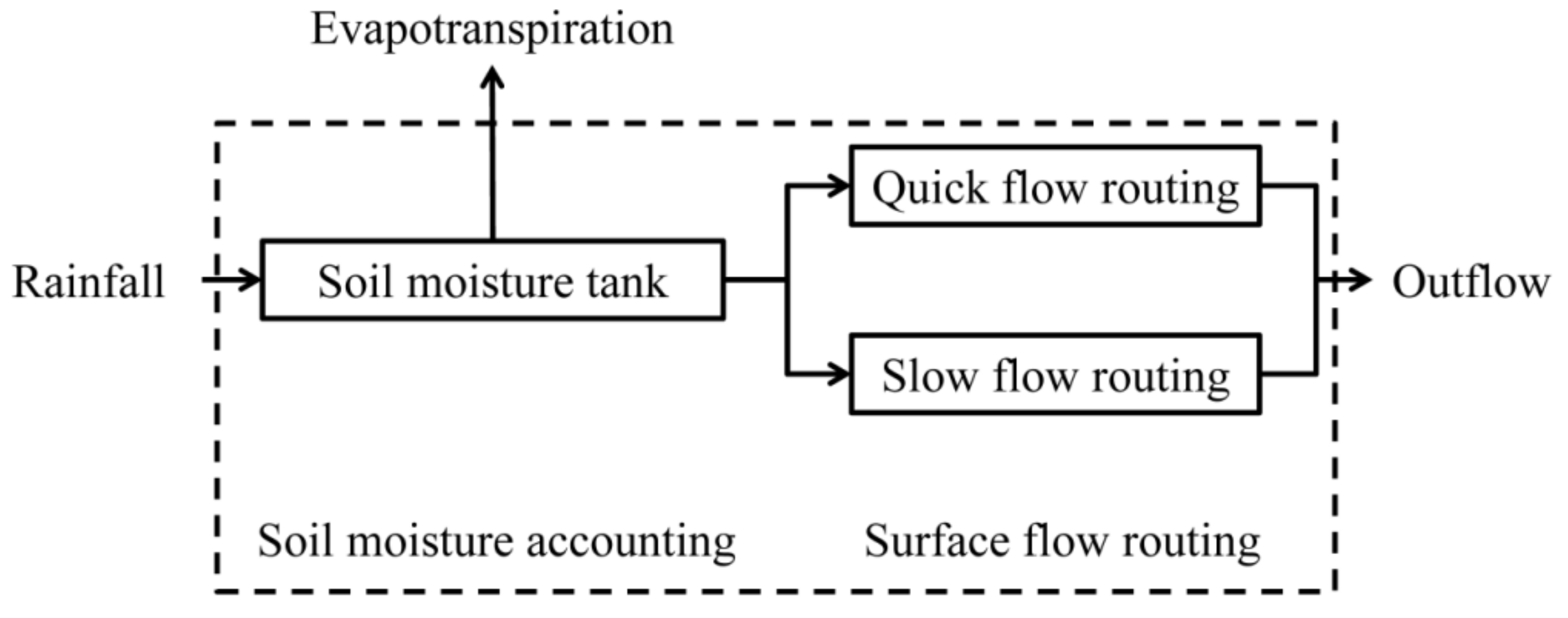

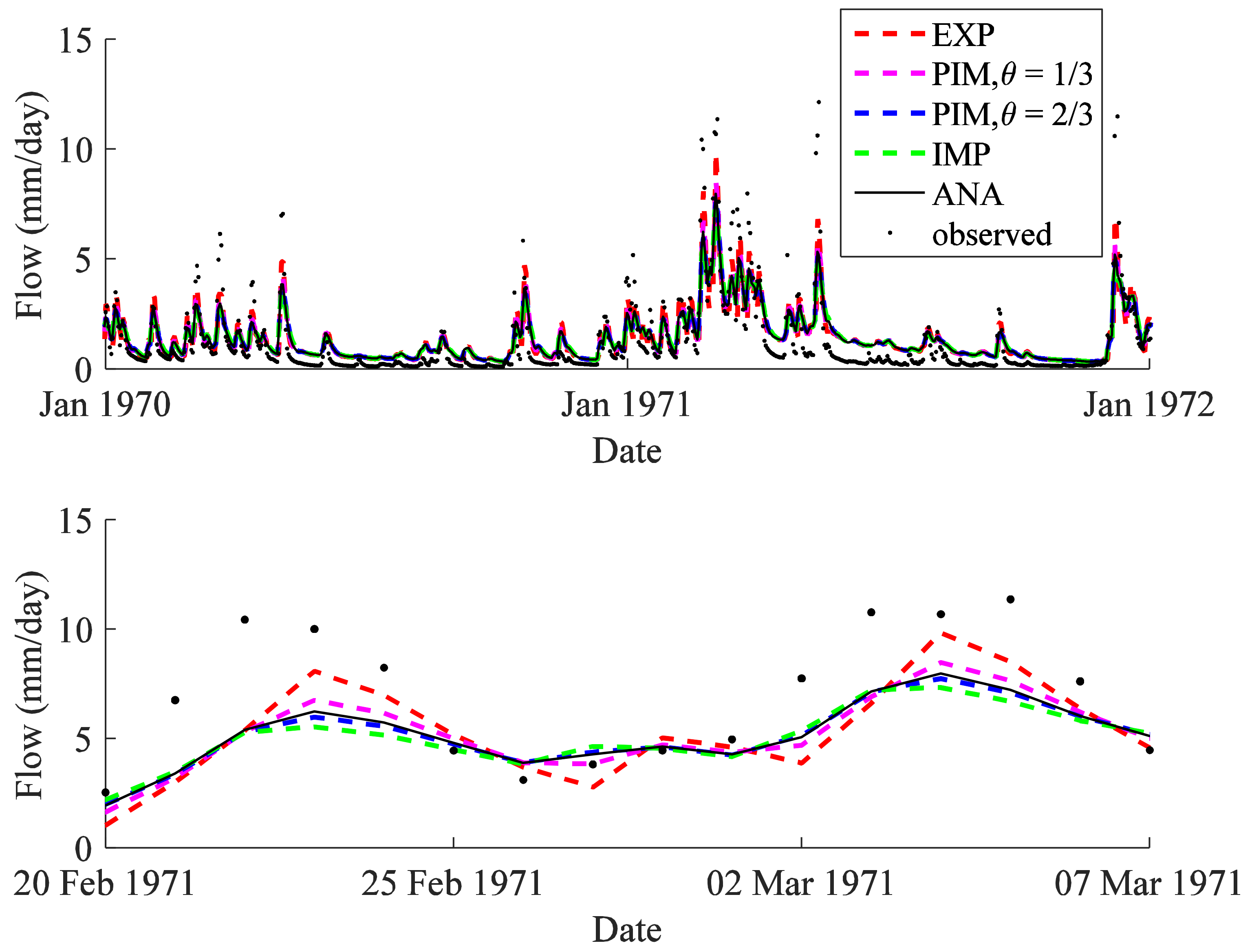
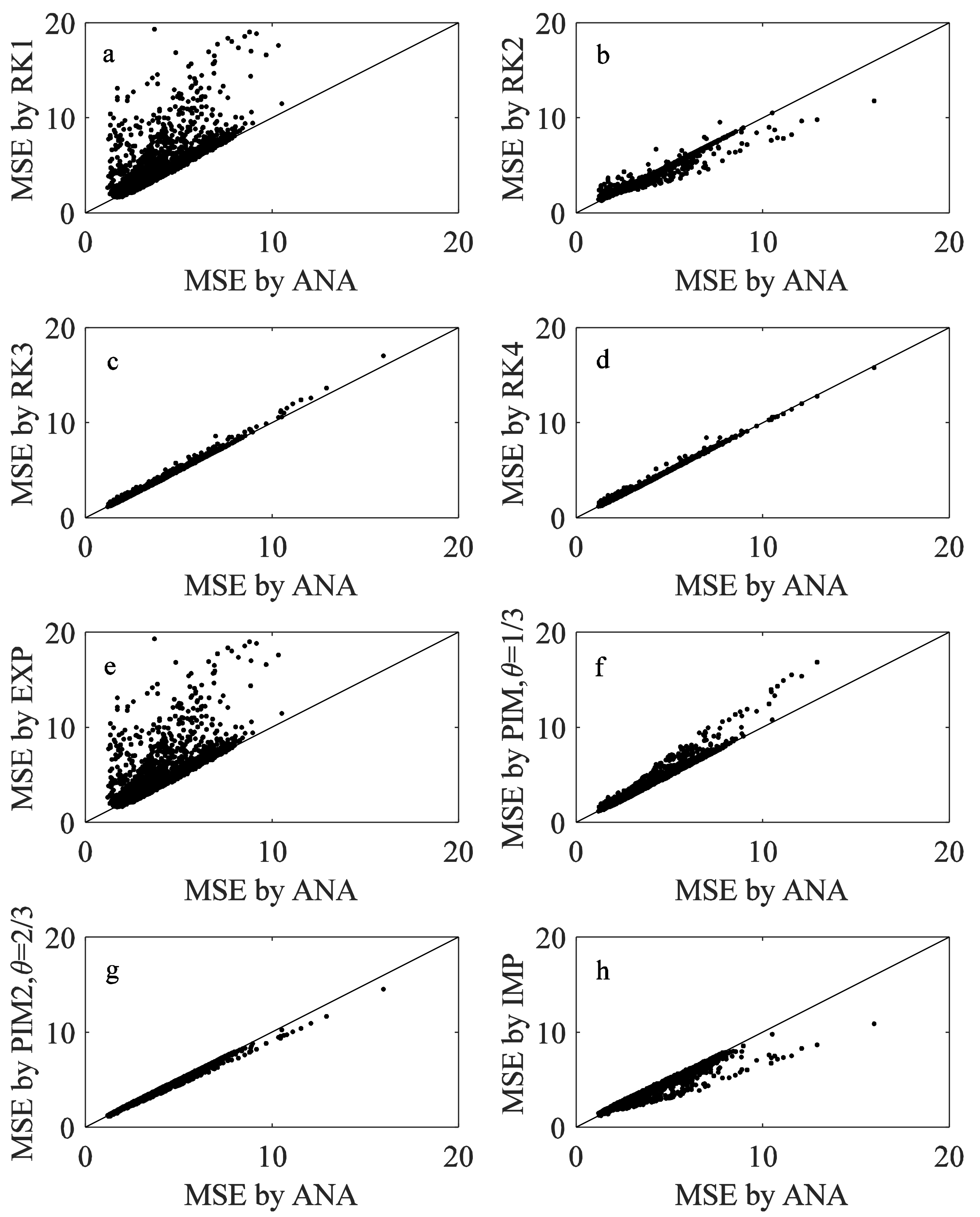
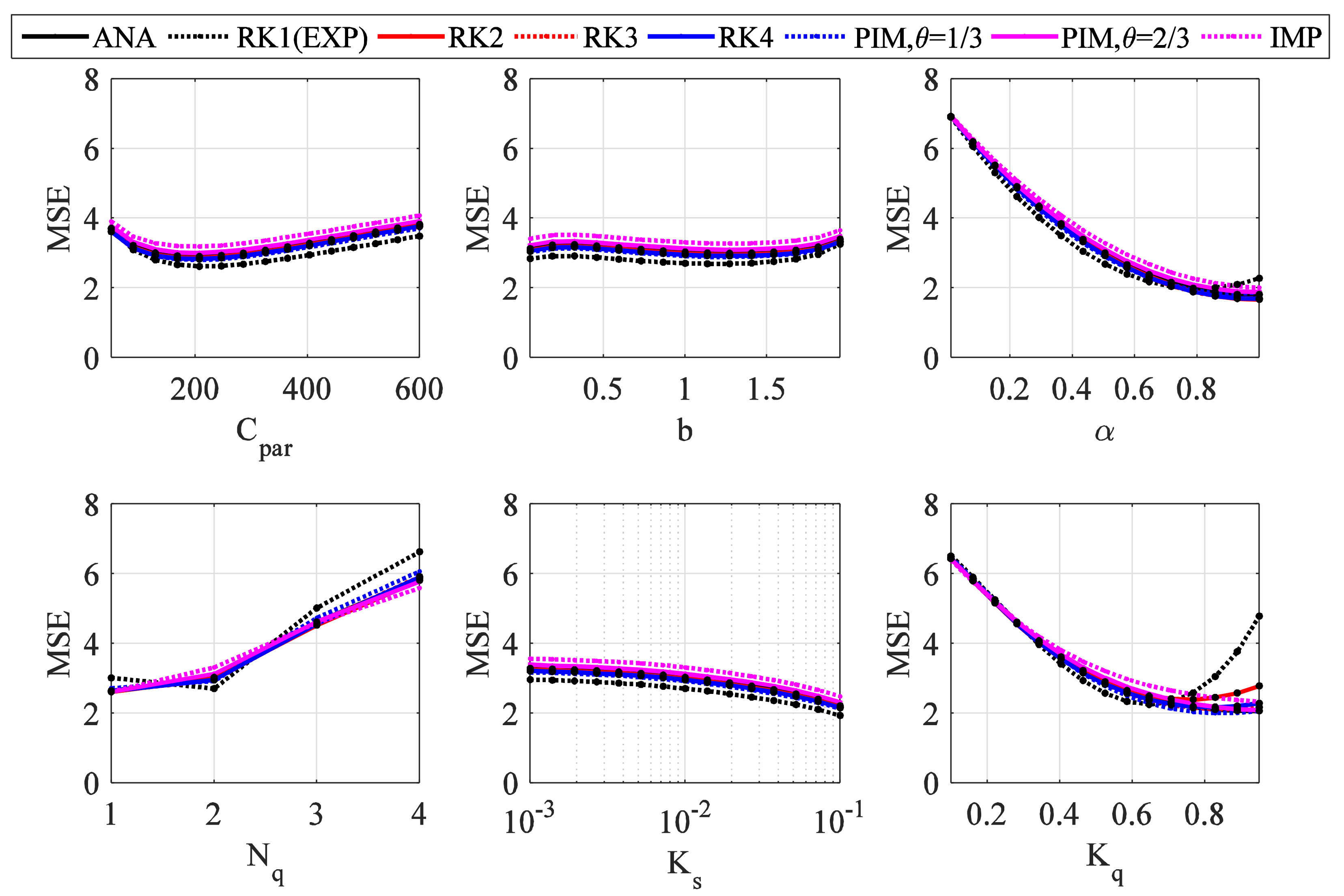

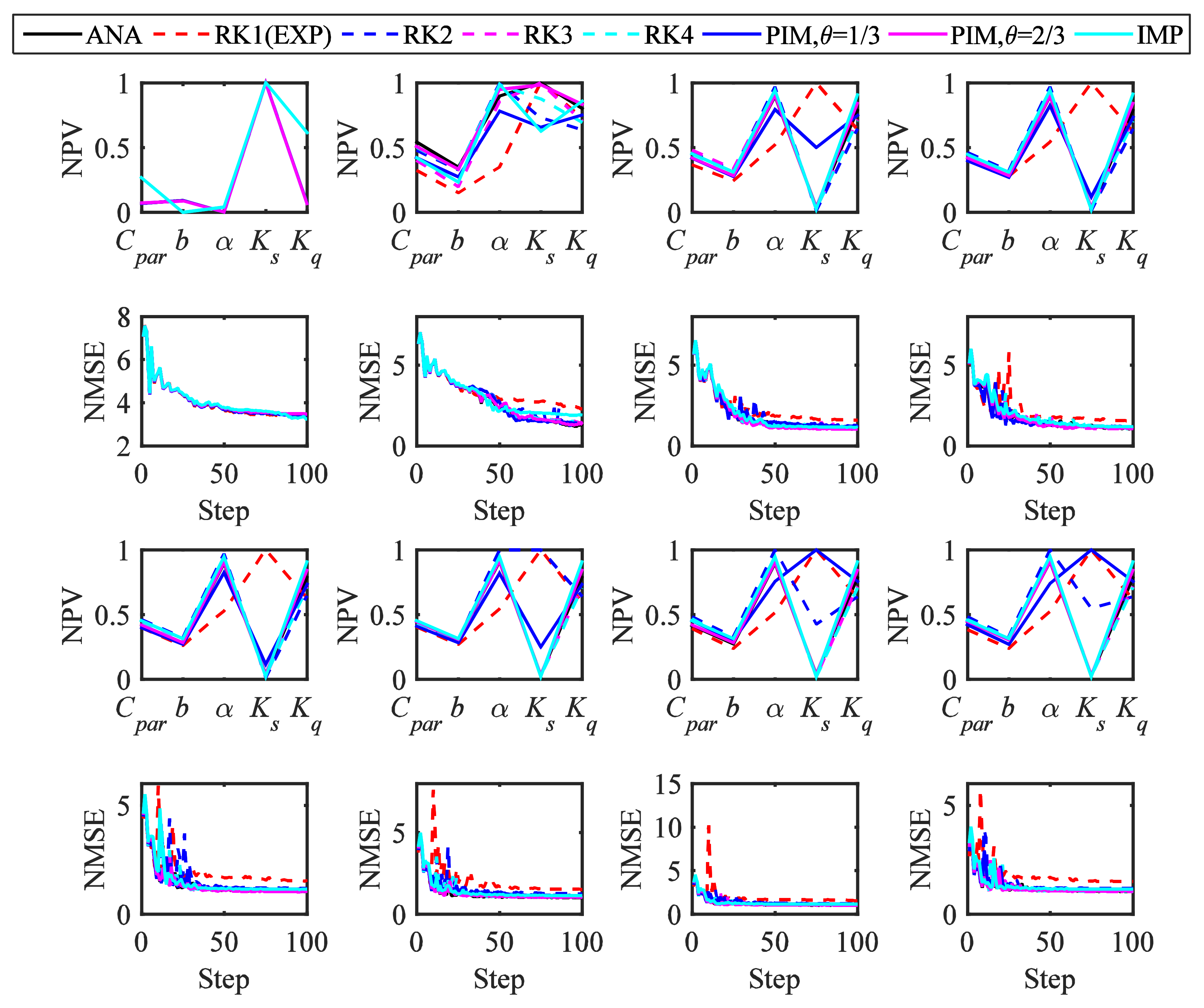
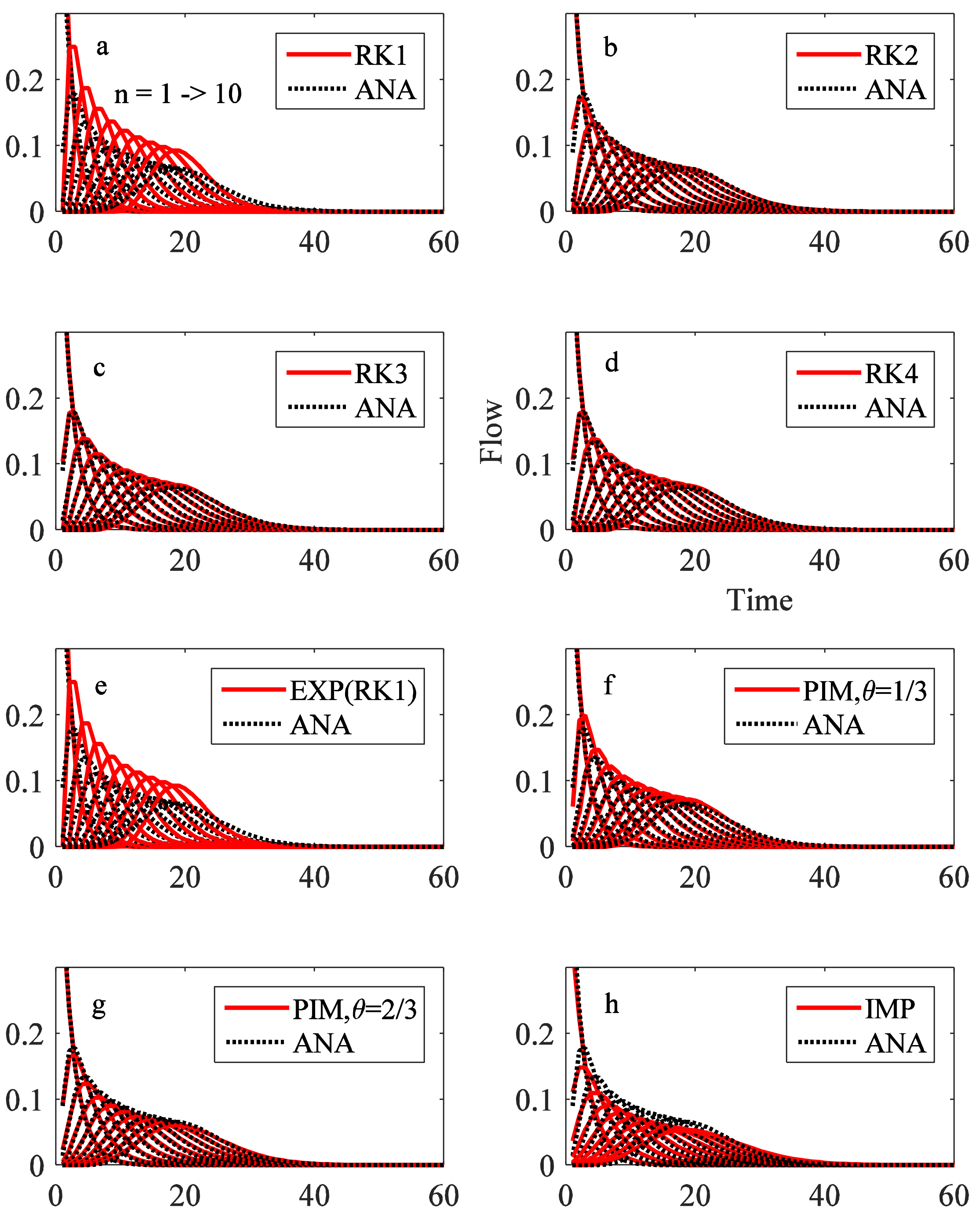
| Parameter | Cpar | b | α | Nq | Ks | Kq |
|---|---|---|---|---|---|---|
| Priori value | 300 | 1 | 0.5 | 2 | 0.01 | 0.5 |
| Range | 50–600 | 0.05–1.95 | 0.01–1.00 | 1, 2, 3, 4 | 0.001–0.1 | 0.1–0.95 |
| Set | Cpar | b | α | Nq | Ks | Kq |
|---|---|---|---|---|---|---|
| 1 | 200 | 0.2 | 0.1 | 2 | 0.01 | 0.2 |
| 2 | 250 | 0.4 | 0.2 | 2 | 0.02 | 0.3 |
| 3 | 300 | 0.6 | 0.3 | 2 | 0.03 | 0.4 |
| 4 | 350 | 0.8 | 0.4 | 2 | 0.04 | 0.5 |
| 5 | 400 | 1 | 0.5 | 2 | 0.05 | 0.6 |
| 6 | 450 | 1.2 | 0.6 | 2 | 0.06 | 0.7 |
| 7 | 500 | 1.4 | 0.7 | 2 | 0.07 | 0.8 |
| 8 | 550 | 1.6 | 0.8 | 2 | 0.08 | 0.9 |
| Scheme | MSEmin | Cpar | b | α | Nq | Kq | Ks | Same Parameter set as ANA? |
|---|---|---|---|---|---|---|---|---|
| ANA | 1.18 | 318.07 | 0.58 | 0.80 | 2 | 0.02 | 0.020 | - |
| RK1(EXP) | 1.64 | 238.19 | 0.48 | 0.85 | 1 | 0.09 | 0.088 | No |
| RK2 | 1.64 | 238.19 | 0.48 | 0.85 | 1 | 0.09 | 0.088 | No |
| RK3 | 1.16 | 318.07 | 0.58 | 0.80 | 2 | 0.02 | 0.020 | Yes |
| RK4 | 1.20 | 318.07 | 0.58 | 0.80 | 2 | 0.02 | 0.020 | Yes |
| PIM131 | 1.20 | 318.07 | 0.58 | 0.80 | 2 | 0.02 | 0.020 | Yes |
| PIM231 | 1.16 | 284.67 | 0.30 | 0.85 | 2 | 0.00 | 0.002 | No |
| IMP | 1.24 | 306.51 | 0.38 | 0.95 | 2 | 0.01 | 0.010 | No |
| Scheme | Time (seconds) 1 | |
|---|---|---|
| Nash Cascade simulation (200,000 times) | Random simulation (2000 random sets) | |
| ANA | 3960.6 | 3407.9 |
| RK1 | 227.1 | 2748.7 |
| RK2 | 244.3 | 2992.9 |
| RK3 | 265.7 | 3023.5 |
| RK4 | 268.0 | 3051.6 |
| PIM13 2 | 247.6 | 2900.8 |
| PIM23 2 | 246.7 | 2898.5 |
| IMP | 246.7 | 2899.9 |
| Scheme | Parameter Set | |||||||
|---|---|---|---|---|---|---|---|---|
| Set 1 | Set 2 | Set 3 | Set 4 | Set 5 | Set 6 | Set 7 | Set 8 | |
| RK1 | G | A | P | P | P | P | P | P |
| RK2 | G | A | A | A | A | P | P | P |
| RK3 | G | A | G | G | G | G | G | G |
| RK4 | G | A | G | G | G | G | G | G |
| PIM13 1 | G | A | P | G | G | A | P | P |
| PIM23 1 | G | G | G | G | G | G | G | G |
| IMP | P | A | A | A | A | A | A | A |
© 2019 by the authors. Licensee MDPI, Basel, Switzerland. This article is an open access article distributed under the terms and conditions of the Creative Commons Attribution (CC BY) license (http://creativecommons.org/licenses/by/4.0/).
Share and Cite
Zhang, S.; Al-Asadi, K. Evaluating the Effect of Numerical Schemes on Hydrological Simulations: HYMOD as A Case Study. Water 2019, 11, 329. https://doi.org/10.3390/w11020329
Zhang S, Al-Asadi K. Evaluating the Effect of Numerical Schemes on Hydrological Simulations: HYMOD as A Case Study. Water. 2019; 11(2):329. https://doi.org/10.3390/w11020329
Chicago/Turabian StyleZhang, Shiyan, and Khalid Al-Asadi. 2019. "Evaluating the Effect of Numerical Schemes on Hydrological Simulations: HYMOD as A Case Study" Water 11, no. 2: 329. https://doi.org/10.3390/w11020329
APA StyleZhang, S., & Al-Asadi, K. (2019). Evaluating the Effect of Numerical Schemes on Hydrological Simulations: HYMOD as A Case Study. Water, 11(2), 329. https://doi.org/10.3390/w11020329





